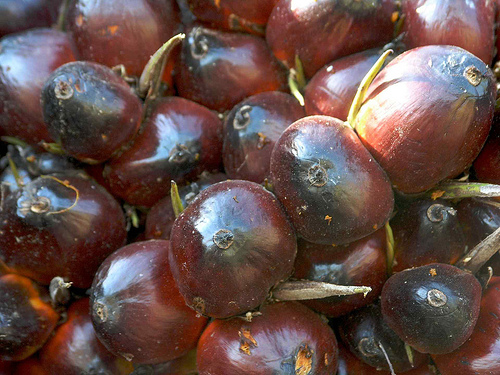Bacon has been the darling comfort food lately, with recipes abounding for bacon in everything possible including mayonnaise and ice cream. But you might want to hold that extra slice. A new Harvard analysis shows that one daily serving of processed red meat (a hot dog or two slices of bacon) increased overall mortality risk by 20%. One daily serving of unprocessed red meat (about the size of a deck of cards) increased risk of death by 13%.
The findings are based on two large ongoing studies from the Harvard School of Public Health: the Nurse’s Study of 83,644 women and the complementary Health Professionals Follow-up Study of 37,698 men. Since 1976 these studies have explored the links between diet, lifestyle, and health outcomes, questioning participants every four years about their diet and other health factors and investigating and tallying causes of death.
Yesterday an analysis of the results, Red Meat Consumption and Mortality, was published in a free, full-text online version through the Annals of Internal Medicine. The analysis considered the women’s diets from 1980-2008 and the men’s from 1986-2008.
Study participants who ate more meat also smoked more, drank more, weighed more, and were less active, but the analysis controlled for all those variables and more. The study revealed a striking relationship between the number of servings of red meat per day and the risk of death.
Among specific causes of death, an extra serving of red meat a day increased cardiovascular-related deaths by 18% (unprocessed meat) and 21% (processed meat). For cancer, the corresponding increases in death rate were 10% and 16%.
The authors hypothesize that some of the potentially harmful factors in red meat may be heme iron, saturated fat, nitrates, and carcinogins that are formed when meat is cooked at high temperatures. Extra sodium and nitrates may explain why processed meat is a higher risk factor than processed meat. There was a trend toward bacon and hot dogs being higher risk than other kinds of processed meat like sausage.
Red meat is the best source of iron, which can certainly be needed and beneficial. But excessive iron stores are known to the risk of fatal heart disease, especially in men.
Saturated fat is also known to increase the risk of heart disease and cancers. This study was not able to distinguish between eating lean and fatty kinds of meat, which is a difference worthy of further study.
Those who ate more red meat also ate fewer fruits, vegetables, and whole grains. So part of the story may be that meat-eaters were missing the protective factors that can be found in these foods, rather than simply being harmed by factors found in meat.
Each serving of total red meat replaced by a serving of an alternate protein source was associated with a lower risk of death: 7% less for fish, 14% for poultry, 19% for nuts, 10% for legumes, 10% for low-fat dairy products, and 14% for whole grains. The researchers estimated that 9.3% of deaths in men and 7.6% in women during the study period could have been prevented if all the participants had consumed less than half a serving a day of red meat.
“This study provides clear evidence that regular consumption of red meat, especially processed meat, contributes substantially to premature death,” said study author Frank Hu, MD. “On the other hand, choosing more healthful sources of protein in place of red meat can confer significant health benefits by reducing chronic disease morbidity and mortality.”
Another interesting finding of the study is that American meat consumption is declining, at least among the largely well-educated, mostly non-Hispanic white study population. Women’s red meat eating declined from around one serving to half a serving per day, while men’s portions declined slightly from .75 to .63 servings.
You’ll find lots of ideas for good meals not including red meat in the rest of this blog.







{ 4 comments… read them below or add one }
Thank you for your summary of this article, Mary. I think the study misleading. As you point out, the study design and data did not distinguish from corn-fattened meat and lean, grass-fed, red meat. This latter meat is rich in heart healthy Omega-3s. Also, these meat eaters ate fewer fruits and vegetables. Being overweight, sedentary and smoking are such high risk factors for heart disease, I don’t know how you just statistically factor those risks out of the equation.
In the last three months, my husband and I have moved from healthy vegetarian to a diet of vegetables, fruits, fish, eggs, walnuts, and lean and fat-trimmed, grass-fed local organic meats (chicken, turkey, pork, bison, and beef). Period. No grains , beans, soy, or dairy of any kind. (Except for the occasional potluck). One iteration of this eating program is called the Paleo Diet. Besides being easy, filling and delicious, our vegetable and fruit consumption has gone way up over our vegetarianism, now that we eat them at every meal and snack instead of grains.
Breakfast: Pacific salmon poached in salsa with brussel sprouts and mango. Lunch: Tomato sauce with lean ground bison over spagetti squash (leftovers). Snacks: Walnuts, 1 date, 1 small square chocolate, orange, celery. Tonight we grilled skewers of local chicken and vegetables over a back-yard campfire, for the whole Paleo effect (non-fossil fuel cooking). Drinks: tea infusions, carrot juice. Supplements: Vit D, Calcium, and Magnesium.
After 3 months on our experiment I can report: Loss of 15 lbs without “dieting” or feeling hungry, reduction of the middle-age inflamatory aches and pains, and none of the usual spring seasonal allergies. My thin, active husband with “genetic” hypercholesterolemia can report a reduction of his total cholesterol and LDL by 23%, and an increase of HDL by 15% — all back into the normal range, with only these dietary changes! We will be continuing “the experiment” as our regular eating program.
Just like vegetarians do not “miss” meat, we now just think “we don’t eat that food” when confronted with hand-sized cookies or cakelike muffins dripping with transfats or bagels so big as to be 4 servings in one sandwich. No, now it is easy to just “walk on by.”
We recommend it for others looking to maximize healthy diet. It is possible to start with an trial experimental period. Check out the Paleo web sites and set some individualized goals. Then, try it and see what happens.
Hi Kate. I’m sure that cutting out all grains and sugars really helped on the weight loss front: that’s the basic idea of Atkins and it works there, too. And the resulting weight loss would be helpful for bringing down cholesterol numbers– that’s been shown in some studies of the Atkins diet. That doesn’t mean, though, that Atkins is a healthy way to eat in the long term. The weight loss you experienced would also be very helpful in decreasing arthritis symptoms and therefore cutting down on those middle-aged aches and pains. Losing weight is one of the best things you can do for arthritis. You mentioned cutting out bakery items with trans-fats– that would also help improve blood chemistry, even without weight loss, and may have been a factor in the improvement your husband experienced even starting the diet, as you say, thin.
It would be interesting to know if it was cutting out dairy that improved your allergies so much. Dairy can certainly increase stuffiness and mucus production in some people (including me) and for me it makes my allergy symptoms much worse.
Paleo in its current spin is a lot like Atkins but with an anthropological/evolutionary spin. I respect the idea of looking at what we are evolutionarily adapted to in determining our healthiest lifestyle, though I don’t agree with the conclusions some in the recent Paleo camp have drawn. It would take a whole series of posts to discuss why, but this comment is at least a start.
You mention that you are using lean, fat-trimmed meat, which shows that you are concerned to avoid too much saturated fat. That’s good. The current wave of Paleo doesn’t show a concern to avoid saturated fat and regards all saturated fats as healthy. That wasn’t true of the first paleo-type book The Paleolithic Prescription, written over 20 years ago and now out of print, which I find much more sensible than current writers like Cordain.
It’s great that you’ve increased your fruit and vegetable consumption, but it’s also pretty unusual that you would be eating more fruits and vegetables on a paleo diet than a vegetarian diet. Vegetarian diets usually include more fruits and vegetables than the standard American diet, while the current interpretation of the ‘paleo’ diet de-emphasizes fruits and vegetables. Actual hunter-gatherers ate a whole variety of diets, some with a great deal of plant-based food and others, like Arctic peoples, with very little. I’m sure it’s healthier for you that you are eating lots of fruits and vegetables, there is a lot of scientific evidence for that.
You mention Omega 3’s in grass-fed meat. Omega 3 to Omega 6 balance is an important factor in diet and including more Omega 3’s can, as you hint at, have an anti-inflammatory effect. I pay attention to Omega 3 to Omega 6 balance in my diet and in my recipes as well. It can be perfectly well addressed in a diet that does not include red meat.
As you go on in your experiment, you might want to try adding soy and legumes back into your diet. There is a lot of misinformation about soy pinging around the Internet, much of it from the new paleo camp, for example the idea that Asian cultures eat very little soy. Here are some good references about soy for you: http://www.veganhealth.org/articles/soy_harm, http://www.theveganrd.com/2011/03/soyfoods-in-asia-how-much-do-people-really-eat.html. You could also try adding some grain, perhaps a little brown rice here and there, while still continuing to avoid those bagels and cookies, and see what effect that has.
The current wave of paleos believe that a vegetarian diet can’t be healthy, and there’s a paleo meme about unhealthy vegetarians who see the light, start eating a lot of meat, and get healthy. Your post echoes that meme though you may not have intended that. There’s even a book The Vegetarian Myth promoting that view, and good review/response to that book by an RD is here: http://www.theveganrd.com/2010/09/review-of-the-vegetarian-myth.html.
Meanwhile, if you like good old fruits and vegetables, you’ll certainly find lots of them on my blog, along with plenty of wheat and dairy-free recipes.
I also would like to see a study in free range grass Fed meats vs corn Fed, caged or penned animals ( which the majority of Americans also eat). Many studies refer to red beef but don’t differentiate between the two. Then many folks switch to chicken. Chickens raised in cages, not seeing the light of day, Fed antibiotics and a diet to plump them up; this can’t be healthy either. The whole chickens you can buy at the stores (more rare these days as the ” best meat ” is breast meat) are disgusting and fatty. What happened to the other part of the bird…I can only imagine. Sorry just thinking out loud
Yes, Laurie, it would be great to see a study like that, there are certainly good reasons to think that free-ranged animals might produce healthier meat. It certainly contains more omega-3’s, and I would imagine it would be leaner, too. You are right that Americans have shifted their meat-eating from beef to cage-raised chicken. In addition to being inhumane, it does seem likely that battery-cage-raised chicken would be less healthy. When my mom was here we went to a meat store so she could buy whole chicken that she thought was acceptable– I’m sure it was more costly yet healthier than your typical supermarket chicken.